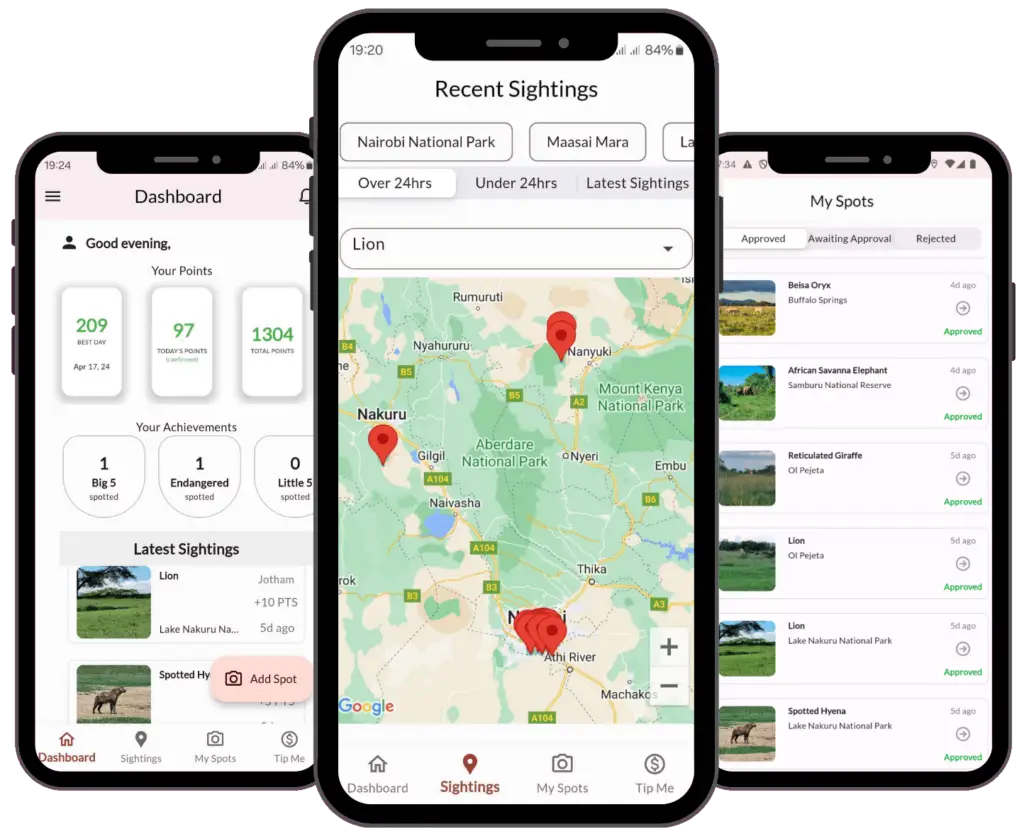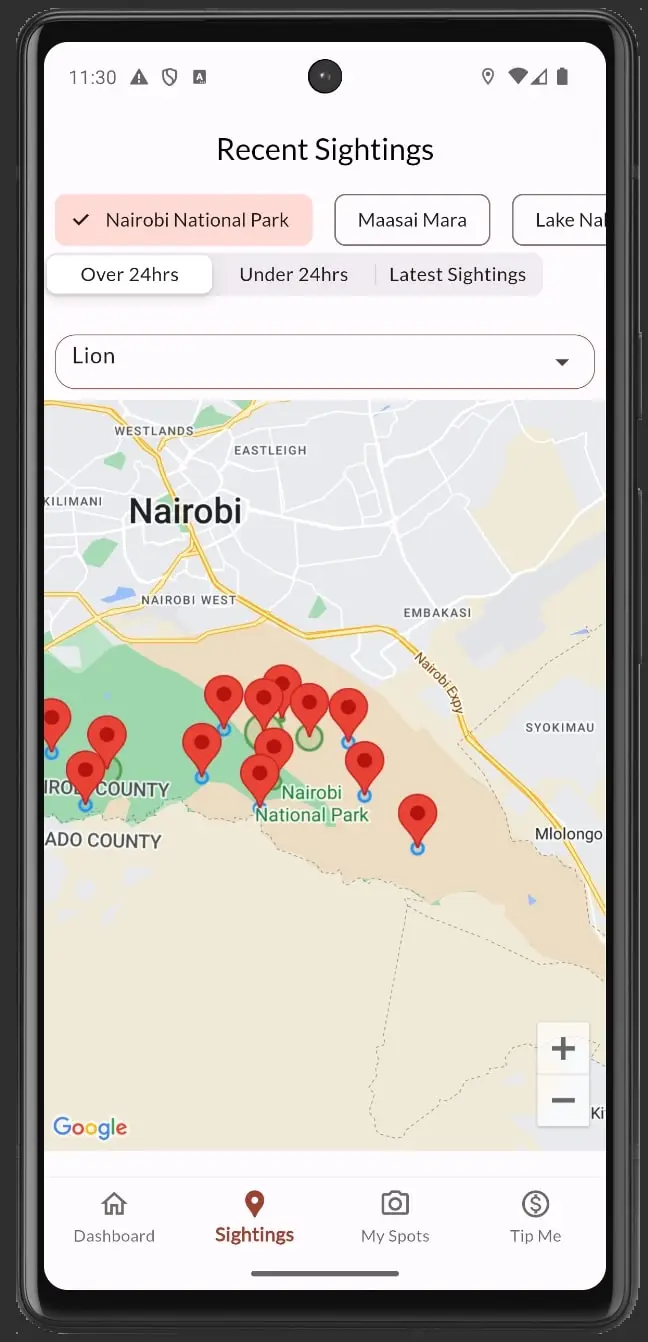All images and facts are contributed by users. Want to contribute or have spotted an error? Email us at hello@safari-driver.com. Image rights belong to the original contributors. Search by: Animal (e.g., Giraffe, Eagle), Category (e.g., Big, Special), or Conservation Status (e.g., Endangered, Vulnerable)
SWAHILI NAME: Nyani
CONSERVATION STATUS: Least Concern
POTENTIAL LOOKALIKES: Monkeys
DISTINGUISHED BY: Long snout and robust build
1. Lives in troops and communicates using over 30 sounds—grunts, barks, screams—plus gestures like yawns and lip-smacking.
2. Omnivorous; eats plants and animals. Males have canines that can be longer than a leopard’s!
PHOTO CREDIT: Jotham A
SWAHILI NAME: Ngole/Gangawia/Peku
CONSERVATION STATUS: Least Concern
POTENTIAL LOOKALIKES: Green mamba, vine snake
DISTINGUISHED BY: Large eyes, slender body, and keeled scales
1. Highly venomous with exceptional camouflage; body and eye color vary widely.
2. Unlike most snakes, boomslangs have excellent binocular vision for hunting.
PHOTO CREDIT: Erasti Photography
SWAHILI NAME: Nyati/Mbogo
CATEGORY: Big 5
CONSERVATION STATUS: Vulnerable
POTENTIAL LOOKALIKES: N/A in Africa (Bison, Water Buffalo)
DISTINGUISHED BY: Large, curved horns and robust build
1. One of Africa’s most dangerous animals due to their unpredictable behavior and strength
2. Have excellent memory and can recall predators and people they encounter
PHOTO CREDIT: Jotham A
SWAHILI NAME: Pongo/Kulungu/Mbawala
CONSERVATION STATUS: Least Concern
POTENTIAL LOOKALIKES: Duiker, Reedbuck
DISTINGUISHED BY: Spiral horns (males) and spotted coat
1. Shy and solitary, they prefer dense bush habitats
2. Excellent jumpers, they evade predators with powerful leaps
PHOTO CREDIT: Jotham A
SWAHILI NAME: Tandawala Tumbo-Jeupe
CONSERVATION STATUS: Least Concern
POTENTIAL LOOKALIKES: Other Bustards
DISTINGUISHED BY: White belly, long legs, and blue-gray neck of males
1. Found in open grasslands and savannahs, often spotted in pairs or alone
2. Males have blue-gray necks and dark facial markings, while females are more muted in color, and both have a distinctive croaking call
PHOTO CREDIT: Jotham A
SWAHILI NAME: Shakivale Tumbo-jeupe
CONSERVATION STATUS: Least Concern
POTENTIAL LOOKALIKES: Other Hawks, Eagles
DISTINGUISHED BY: Chunky body and reddish-orange tail.
1. Part of the hawk family, not the eagle family.
2. Underparts may vary in color, ranging from white to black or chestnut, particularly in Somalia.
PHOTO CREDIT: Jotham A
SWAHILI NAME: Duma
CONSERVATION STATUS: Endangered
POTENTIAL LOOKALIKES: Leopard
DISTINGUISHED BY: Slender body, black tear marks, less muscular than Leopard
1. The fastest land animal, reaching up to 110 km/h but tiring after ~100 meters
2. Among the oldest cat species, with a lineage dating back nearly 4 million years.
PHOTO CREDIT: Erasti Photography
SWAHILI NAME: Korongo Taji Kijivu
CONSERVATION STATUS: Endangered
POTENTIAL LOOKALIKES: Black Crowned Crane
DISTINGUISHED BY: Golden crest and grey feathers
1. Known for elaborate mating dances and monogamous behavior
2. National bird of Uganda
PHOTO CREDIT: Jotham A
SWAHILI NAME: Mamba
CONSERVATION STATUS: Least Concern
POTENTIAL LOOKALIKES: N/A in Africa (Saltwater Crocodile, Alligator)
DISTINGUISHED BY: Long snout and powerful jaws
1. Second-largest reptile on Earth after the saltwater crocodile (not found in Africa)
2. Known for caring for their young, both parents ferociously guarding nests and hatchlings
PHOTO CREDIT: Jotham A
SWAHILI NAME: Bata-miti Rangi-mbili
CONSERVATION STATUS: Least Concern
POTENTIAL LOOKALIKES: Other Ducks
DISTINGUISHED BY: Caramel-brown body, long neck and legs, pale side stripe
1. Whistling-ducks were once called “tree ducks” for their habit of roosting in trees.
2. Pairs bond for years, and both parents help raise the young—more like swans than typical ducks.
PHOTO CREDIT: Jotham A
SWAHILI NAME: (Tai) Pungu
CONSERVATION STATUS: Endangered
POTENTIAL LOOKALIKES: Other eagles
DISTINGUISHED BY: Bright red face and short tail
1. Performs acrobatic flight displays, including barrel rolls and steep dives
2. Known for its short tail, unusual for eagles, contributing to its agility in flight
PHOTO CREDIT: Jotham A
SWAHILI NAME: Furukombe/Tai Mlasamaki
CONSERVATION STATUS: Least Concern
POTENTIAL LOOKALIKES: Osprey
DISTINGUISHED BY: Larger size, white head, and piercing call
1. Prey includes fish, birds, hyraxes, monkeys, and even crocodile hatchlings
2. Females can be up to 20% larger than males
PHOTO CREDIT: Jotham A
SWAHILI NAME: Tai Ushungi
CONSERVATION STATUS: Least Concern
POTENTIAL LOOKALIKES: Crowned Eagle, Marital Eagle
DISTINGUISHED BY: A long, shaggy black crest, dark brown-black plumage, and striking yellow eyes
1. Its dramatic crest stands upright when alert or excited and lies flat when relaxed.
2. Unlike many eagles, it hunts from a perch rather than soaring, waiting patiently before swooping on prey.
PHOTO CREDIT: Erasti Photography
SWAHILI NAME: Tai Ngwilizi
CONSERVATION STATUS: Endangered
POTENTIAL LOOKALIKES: Crowned Eagle, Long-crested Eagle
DISTINGUISHED BY: Piercing yellow-gold eyes, white underbody with dark spots
1. Africa's largest eagle, can outweigh American bald eagles
2. Known to hunt and kill lion cubs
PHOTO CREDIT: Jotham A
SWAHILI NAME: Tai Msasi
CONSERVATION STATUS: Vulnerable
POTENTIAL LOOKALIKES: Other Eagles
DISTINGUISHED BY: Large, brown body with dark flight feathers and a pale head.
1. Known for scavenging behavior, often feeding on carcasses.
2. Powerful hunters; one of their main prey, Dik-dik, can weigh twice as much.
PHOTO CREDIT: Jotham A
SWAHILI NAME: Korongo (Msuka, Pwani)
CONSERVATION STATUS: Least Concern
POTENTIAL LOOKALIKES: Ibis
DISTINGUISHED BY: Slender neck and white plumage
1. An Egret is a type of heron.
2. Egrets often follow large animals or fishermen to catch prey stirred up by movement in the water.
PHOTO CREDIT: Luvai Gohar
SWAHILI NAME: Bata Bukini wa Misri
CONSERVATION STATUS: Least Concern
POTENTIAL LOOKALIKES: Ducks, Geese
DISTINGUISHED BY: Reddish-brown eye patches and pink legs
1. More closely related to ducks than to true geese. Seen in ancient Egyptian artwork.
2. Sometimes perch on hippos to feed on stirred-up plants and animals.
PHOTO CREDIT: Jotham A
SWAHILI NAME: Pofu
CONSERVATION STATUS: Least Concern
POTENTIAL LOOKALIKES: Kudu
DISTINGUISHED BY: Large size and twisted horns
1. Largest antelope species in the world
2. Can jump over 6 feet from a standstill
PHOTO CREDIT: Jotham A
SWAHILI NAME: Tembo/Ndovu
CATEGORY: Big 5
CONSERVATION STATUS: Endangered
POTENTIAL LOOKALIKES: N/A in Africa
DISTINGUISHED BY: Massive size, trunk, and tusks
1. Two species: savanna elephants (larger with outward-curving tusks) and forest elephants (darker with straight, downward-pointing tusks)
2. Calves can stand within 20 minutes of birth and walk within 1 hour
PHOTO CREDIT: Jotham A
SWAHILI NAME: Heroe
CONSERVATION STATUS: Vulnerable
POTENTIAL LOOKALIKES: None (distinctive)
DISTINGUISHED BY: Pink feathers and long legs
1. Greater flamingos are larger with pale pink plumage and a pink bill with a black tip, while lesser flamingos are smaller, deeper pink, and have a darker bill with a red base and black tip.
2. Their pink color comes from carotenoid pigments in algae and shrimp, which are absorbed and stored in their feathers, skin, and beaks. Without this diet, they would be pale or white.
PHOTO CREDIT: Erasti Photography
SWAHILI NAME: Bweha Masigio
CONSERVATION STATUS: Least Concern
POTENTIAL LOOKALIKES: Jackal, Other foxes
DISTINGUISHED BY: Large bat-like ears, raccoon-like face mask
1. Their large ears detect insects underground, even larvae hatching from dung balls.
2. A single bat-eared fox can consume over one million termites annually.
PHOTO CREDIT: Erasti Photography
SWAHILI NAME: Swala Granti
CONSERVATION STATUS: Least Concern
POTENTIAL LOOKALIKES: Thomson’s Gazelle, Impala
DISTINGUISHED BY: Larger size, long curved horns, and a light-colored coat without a strong black stripe.
1. Can survive in dry areas with little water, relying on moisture from food.
2. Built for endurance, it can sustain high speeds over long distances.
PHOTO CREDIT: Bonface Mwangi
SWAHILI NAME: Swala Tomi
CONSERVATION STATUS: Least Concern
POTENTIAL LOOKALIKES: Grant’s Gazelle, Impala
DISTINGUISHED BY: Smaller size, a bold black stripe on its side, and a darker lower body.
1. Known for “pronking” (high, stiff-legged jumps) to confuse predators.
2. One of the fastest antelopes, reaching speeds of up to 80 km/h (50 mph).
PHOTO CREDIT: Luvai Gohar
SWAHILI NAME: Swala Twiga
CATEGORY: Special 5
CONSERVATION STATUS: Vulnerable
POTENTIAL LOOKALIKES: Impala
DISTINGUISHED BY: Long neck
1. Feeds on high branches that other antelopes can’t reach by standing on its hind legs.
2. Rarely drinks water, obtaining moisture from plants, which enables it to thrive in harsh, arid environments.
PHOTO CREDIT: Luvai Gohar
SWAHILI NAME: Twiga
CONSERVATION STATUS: Endangered
POTENTIAL LOOKALIKES: Reticulated giraffe, Nubian (Rothschild’s) giraffe
DISTINGUISHED BY: Jagged, star-like patterns
1. The tallest giraffe species, females give birth while standing, a 5-6 foot drop for the new born
2. Giraffes often sleep less than 30 minutes a day, in 2-3 minute power naps
PHOTO CREDIT: Jotham A
Giraffe, Nubian (Rothschilds)
SWAHILI NAME: Twiga
CONSERVATION STATUS: Critically Endangered
POTENTIAL LOOKALIKES: Masai Giraffe, Reticulated Giraffe
DISTINGUISHED BY: Darker patches, smoother edges than Masai giraffes, set against a pale cream background.
1. It has “white socks,” with no markings below the knees.
2. Unlike most giraffes, it has five ossicones (horn-like bumps on its head).
PHOTO CREDIT: Bonface Mwangi
SWAHILI NAME: Twiga
CATEGORY: Special 5
CONSERVATION STATUS: Endangered
POTENTIAL LOOKALIKES: Masai giraffe, Nubian (Rothschild) giraffe
DISTINGUISHED BY: Hexagonal, “hand-painted” brown patches
1. Chew old bones to stock up on calcium and minerals
2. Can go weeks without drinking water, relying on plant moisture
PHOTO CREDIT: Jotham A
SWAHILI NAME: Kanga
CONSERVATION STATUS: Least Concern
POTENTIAL LOOKALIKES: Vulturine Guineafowl
DISTINGUISHED BY: Black or grey plumage with white spots and a bony casque (helmet) on the head.
1. Roosts in trees at night for safety.
2. Uses loud alarm calls and prefers running to flying when threatened.
PHOTO CREDIT: Jotham A
SWAHILI NAME: Kicheleko/Kororo Tumbusi
CONSERVATION STATUS: Least Concern
POTENTIAL LOOKALIKES: Helmeted Guineafowl
DISTINGUISHED BY: Blue chest, glossy neck feathers, and a vulture-like bare head.
1. Nests may have eggs from multiple hens; chicks can fly within days.
2. Forages in large flocks, often led by a dominant bird, found in open dry areas
PHOTO CREDIT: Jotham A
SWAHILI NAME: Kongoni
CONSERVATION STATUS: Least Concern
POTENTIAL LOOKALIKES: Topi, Blue Wildebeest
DISTINGUISHED BY: Long face and curved horns
1. Like the Topi, stands on termite mounds to spot danger. Runs in a zig-zag to evade predators.
2. Lelwel hartebeest has a longer face and darker coat, while Coke’s hartebeest is lighter with a shorter face and mainly found in Kenya and Tanzania.
PHOTO CREDIT: Luvai Gohar



